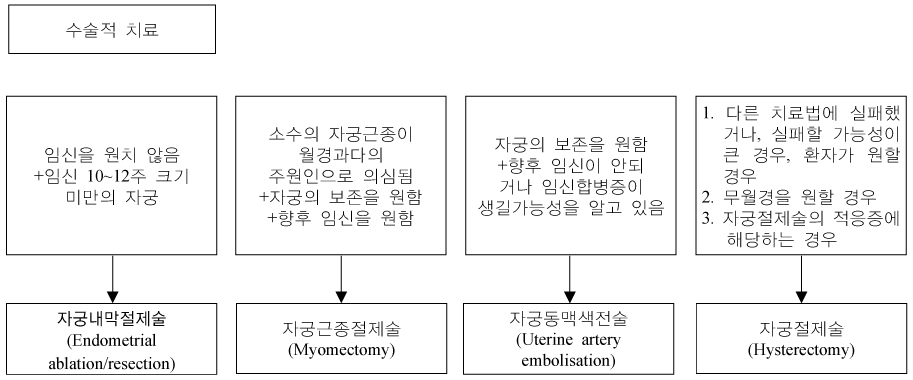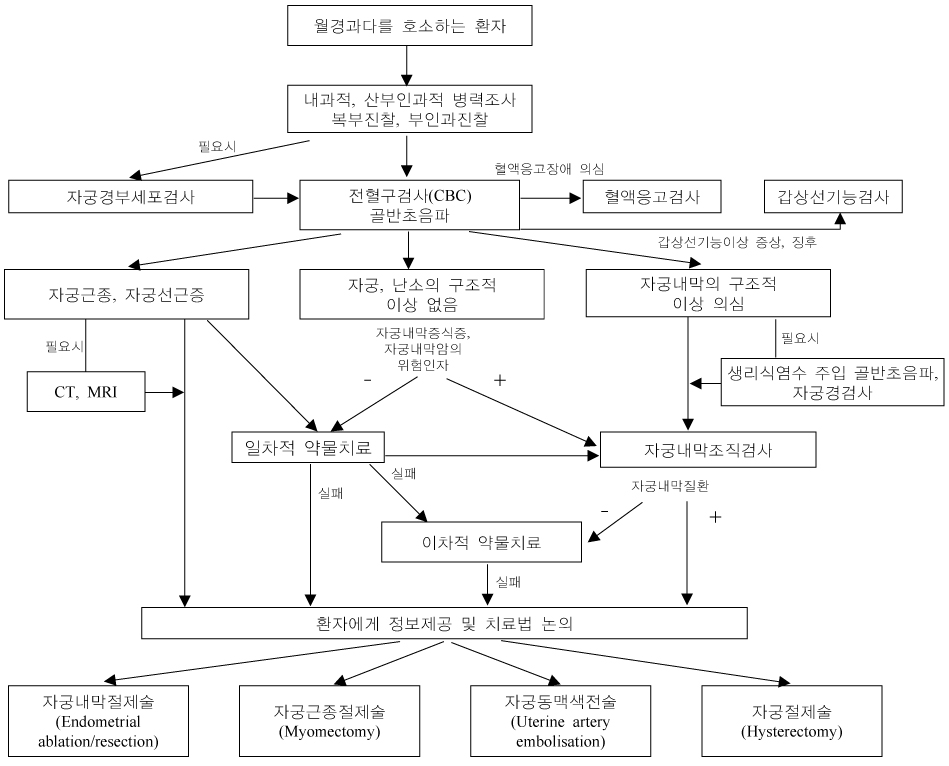Korean J Obstet Gynecol.
2010 Mar;53(3):203-210. 10.5468/kjog.2010.53.3.203.
Guideline for management of heavy menstrual bleeding
- Affiliations
-
- 1Department of Obstetrics and Gynecology, Ewha Womans University School of Medicine, Seoul, Korea.
- 2Department of Obstetrics and Gynecology, Korea University College of Medicine, Seoul, Korea.
- 3Department of Obstetrics and Gynecology, Seoul National University College of Medicine, Seoul, Korea.
- 4Department of Obstetrics and Gynecology, Yonsei University College of Medicine, Seoul, Korea. dr222@yumc.yonsei.ac.kr
- 5Department of Obstetrics and Gynecology, University of Ulsan College of Medicine, Asan Medical Center, Seoul, Korea.
- KMID: 2273845
- DOI: http://doi.org/10.5468/kjog.2010.53.3.203
Abstract
- Heavy menstrual bleeding (HMB) is a common problem in primary care clinic of gynecology. HMB could cause adverse effect on the quality of life of many women. This guideline will provide evidence based information concerning diagnosis and management of HMB. Constructive dialogue should allow patients to be able to trust the advice given by their practitioner as they will be confident that they have and will be able to use it to inform this decision-making process. This guideline has been developed with the aim of providing guidance on HMB. The effectiveness of the various treatments as well as their risks and benefits are discussed in relation to their use in the treatment of HMB. We wish the information contained in this guideline will help clinicians reach a reasonable and beneficial decision with the latest information.
Keyword
MeSH Terms
Figure
Reference
-
1. Harbour RT, Forsyth L, editors. Scottish Intercollegiate Guidelines Network. SIGN 50: a guideline developer\'s handbook. Ediburgh, Scotland: Scottish Intercollegiate Guidelines Network; 2008.2. Sackett DL, editor. Evidence-based Medicine: How to Practice and Teach EBM. 2nd ed. Edinburgh; New York: Churchill Livingstone; 2000.3. Looker AC, Dallman PR, Carroll MD, Gunter EW, Johnson CL. Prevalence of iron deficiency in the United States. JAMA. 1997; 277:973–976.
Article4. Hallberg L, Högdahl AM, Nilsson L, Rybo G. Menstrual blood loss and iron deficiency. Acta Med Scand. 1966; 180:639–650.
Article5. Andrade AT, Souza JP, Shaw ST Jr, Belsey EM, Rowe PJ. Menstrual blood loss and body iron stores in Brazilian women. Contraception. 1991; 43:241–249.
Article6. Janssen CA, Scholten PC, Heintz AP. Reconsidering menorrhagia in gynecological practice. Is a 30-year-old definition still valid? Eur J Obstet Gynecol Reprod Biol. 1998; 78:69–72.7. Farquhar C, Ekeroma A, Furness S, Arroll B. A systematic review of transvaginal ultrasonography, sonohysterography and hysteroscopy for the investigation of abnormal uterine bleeding in premenopausal women. Acta Obstet Gynecol Scand. 2003; 82:493–504.
Article8. Cepni I, Ocal P, Erkan S, Saricali FS, Akbas H, Demirkiran F, et al. Comparison of transvaginal sonography, saline infusion sonography and hysteroscopy in the evaluation of uterine cavity pathologies. Aust N Z J Obstet Gynaecol. 2005; 45:30–35.
Article9. Critchley HO, Warner P, Lee AJ, Brechin S, Guise J, Graham B. Evaluation of abnormal uterine bleeding: comparison of three outpatient procedures within cohorts defined by age and menopausal status. Health Technol Assess. 2004; 8:iii–iv.
Article10. Gimpelson RJ, Rappold HO. A comparative study between panoramic hysteroscopy with directed biopsies and dilatation and curettage. A review of 276 cases. Am J Obstet Gynecol. 1988; 158(3 Pt 1):489–492.11. Lethaby AE, Cooke I, Rees M. Progesterone or progestogen-releasing intrauterine systems for heavy menstrual bleeding. Cochrane Database Syst Rev. 2005; CD002126.
Article12. Reid PC, Virtanen-Kari S. Randomised comparative trial of the levonorgestrel intrauterine system and mefenamic acid for the treatment of idiopathic menorrhagia: a multiple analysis using total menstrual fluid loss, menstrual blood loss and pictorial blood loss assessment charts. BJOG. 2005; 112:1121–1125.
Article13. Lethaby AE, Farquhar C, Cooke I. Antifibrinolytics for heavy menstrual bleeding. Cochrane Database Syst Rev. 2000; CD000249.
Article14. Lethaby A, Augood C, Duckitt K, Farquhar C. Nonsteroidal anti-inflammatory drugs for heavy menstrual bleeding. Cochrane Database Syst Rev. 2007; CD000400.
Article15. Fraser IS, McCarron G. Randomized trial of 2 hormonal and 2 prostaglandin-inhibiting agents in women with a complaint of menorrhagia. Aust N Z J Obstet Gynaecol. 1991; 31:66–70.
Article16. Iyer V, Farquhar C, Jepson R. Oral contraceptive pills for heavy menstrual bleeding. Cochrane Database Syst Rev. 2000; CD000154.
Article17. Coulter A, Kelland J, Peto V, Rees MC. Treating menorrhagia in primary care. An overview of drug trials and a survey of prescribing practice. Int J Technol Assess Health Care. 1995; 11:456–471.18. Lethaby A, Irvine G, Cameron I. Cyclical progestogens for heavy menstrual bleeding. Cochrane Database Syst Rev. 2008; CD001016.
Article19. Friedman AJ, Hoffman DI, Comite F, Browneller RW, Miller JD. Treatment of leiomyomata uteri with leuprolide acetate depot: a double-blind, placebo-controlled, multicenter study. The Leuprolide Study Group. Obstet Gynecol. 1991; 77:720–725.
Article20. Beaumont H, Augood C, Duckitt K, Lethaby A. Danazol for heavy menstrual bleeding. Cochrane Database Syst Rev. 2007; CD001017.
Article21. World Health Organization. Reproductive Health and Research. Medical Eligibility Criteria for Contraceptive Use. Geneva: Reproductive Health and Research, World Health Organization; 2004.22. Marjoribanks J, Lethaby A, Farquhar C. Surgery versus medical therapy for heavy menstrual bleeding. Cochrane Database Syst Rev. 2006; CD003855.
Article23. Cook JR, Seman EI. Pregnancy following endometrial ablation: case history and literature review. Obstet Gynecol Surv. 2003; 58:551–556.
Article24. El-Toukhy T, Hefni M. Pregnancy after hydrothermal endometrial ablation and laparoscopic sterilisation. Eur J Obstet Gynecol Reprod Biol. 2003; 106:222–224.
Article25. Kir M, Hanlon-Lundberg KM. Successful pregnancy after thermal balloon endometrial ablation. Obstet Gynecol. 2004; 103(5 Pt 2):1070–1073.
Article26. Lethaby A, Shepperd S, Cooke I, Farquhar C. Endometrial resection and ablation versus hysterectomy for heavy menstrual bleeding. Cochrane Database Syst Rev. 2000; CD000329.
Article27. Iverson RE Jr, Chelmow D, Strohbehn K, Waldman L, Evantash EG. Relative morbidity of abdominal hysterectomy and myomectomy for management of uterine leiomyomas. Obstet Gynecol. 1996; 88:415–419.28. Myers ER, Barber MD, Gustilo-Ashby T, Couchman G, Matchar DB, McGrory DC. Management of uterine leiomyomata: what do we really know. Obstet Gynecol. 2002; 100:8–17.
Article29. Fedele L, Parazzini F, Luchini L, Mezzopane R, Tozzi L, Villa L. Recurrence of fibroids after myomectomy: a transvaginal ultrasonographic study. Hum Reprod. 1995; 10:1795–1796.
Article30. Malone LJ. Myomectomy: recurrence after removal of solitary and multiple myomas. Obstet Gynecol. 1969; 34:200–203.31. Roopnarinesingh S, Suratsingh J, Roopnarinesingh A. The obstetric outcome of patients with previous myomectomy or hysterotomy. West Indian Med J. 1985; 34:59–62.32. Spies JB, Myers ER, Worthington-Kirsch R, Mulgund J, Goodwin S, Mauro M, et al. The FIBROID Registry: symptom and quality-of-life status 1 year after therapy. Obstet Gynecol. 2005; 106:1309–1318.33. Gupta JK, Sinha AS, Lumsden MA, Hickey M. Uterine artery embolization for symptomatic uterine fibroids. Cochrane Database Syst Rev. 2006; CD005073.
Article34. Siskin GP, Shlansky-Goldberg RD, Goodwin SC, Sterling K, Lipman JC, Nosher JL, et al. UAE versus Myomectomy Study Group. A prospective multicenter comparative study between myomectomy and uterine artery embolization with polyvinyl alcohol microspheres: long-term clinical outcomes in patients with symptomatic uterine fibroids. J Vasc Interv Radiol. 2006; 17:1287–1295.
- Full Text Links
- Actions
-
Cited
- CITED
-
- Close
- Share
- Similar articles
-
- Effectiveness of Levonorgestrel Releasing Intrauterine System in Perimenopausal Women with Heavy Menstrual Bleeding: A Prospective Study at a Teaching Hospital in India
- Adolescent menstrual disorders
- Uterine artery Doppler indices: pulsatility index and resistance index as predictive tools for the incidence of heavy menstrual bleeding related to copper intrauterine contraceptive device
- Endometrial ablation and resection versus hysterectomy for heavy menstrual bleeding: an updated systematic review and meta-analysis of effectiveness and complications
- Pathophysiology and Treatment Guidelines of Dysfunctional Uterine Bleeding



